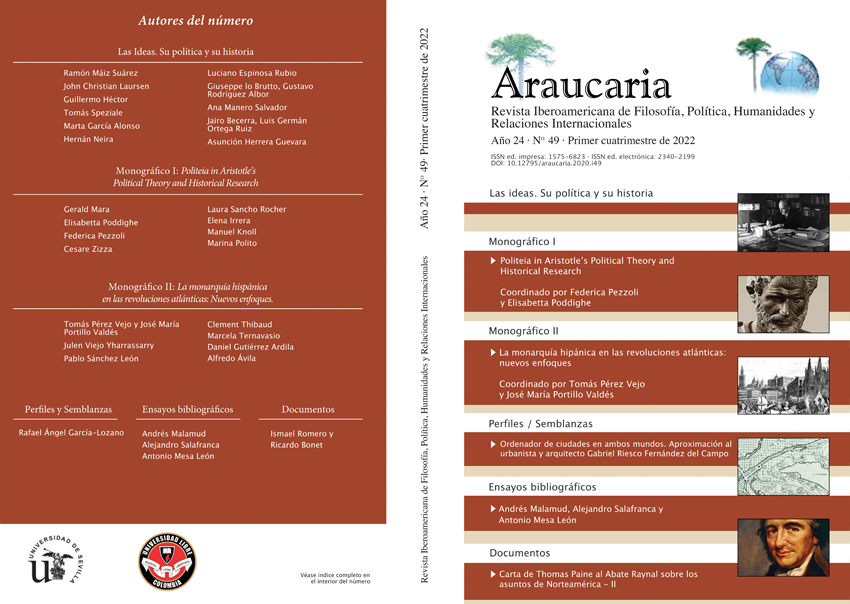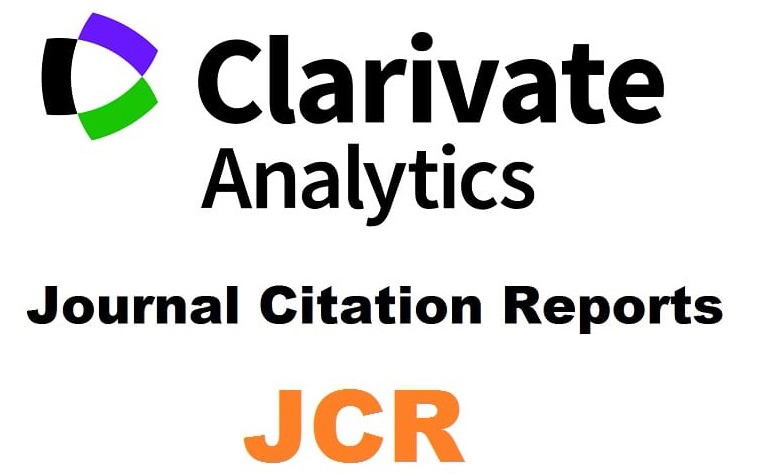Reflexiones sobre el derecho al frío
DOI:
https://doi.org/10.12795.09Keywords:
Right to be cold, environment, human rights, Inter-American System, human rights inflation, greening of human rightsAbstract
The climatic emergency that threats the Arctic constitutes a challenge for the International Community. The inhabitants of this space, mainly indigenous peoples, face a dramatic situation, because their way of life is disappearing. In this context, Arctic peoples formulate the right to be cold. This paper analyzes the implications of this proposal from the point of view of International Human Rights Law, examining the progress made in the link between the environment, climate change and human rights, the initiatives that the Arctic peoples have proposed in the Inter-American System of Human Rights and the theoretical analysis that this proposal generates.
Downloads
References
Sheila Watt-Clouttier, The Right to Be Cold: one Woman’s Fight to Protect the Arctic and Save the Planet from Climate Change, Minneapolis, University of Minnesota Press, 2018, p. 231.
Rebecca M. Bratspies, “Using Human Rights to Improve Arctic Governance” [en Rebecca Pincus y Saleem H. Ali, coords.: Diplomacy on Ice: Energy and the Environment in the Arctic and Antarctic, New Haven, Yale Scholarship Online, 2015], p. 5.
Véase también Rebecca M. Bratspies, “The Climate for Human Rights” en Symposium Climate Wrongs and Human Rights, 72-2 (2018), pp. 308-344.
Adriana Espinosa González, Derechos humanos y medio ambiente: el papel de los sistemas europeo e interamericano, Tesis doctoral, Universidad Carlos III de Madrid, 2015, p. 34 y ss.
Las resoluciones del Consejo de Derechos Humanos sobre derechos humanos y medio ambiente pueden consultarse en https://www.ohchr.org/SP/Issues/HRAndClimateChange/Pages/Resolutions.aspx
Consejo de Derechos Humanos, Los derechos humanos y el cambio climático, Res. 7/23 de 28 de marzo de 2008.
Consejo de Derechos Humanos, Los derechos humanos y el cambio climático, Res. 10/4 de 25 de marzo de 2009.
Consejo de Derechos Humanos, Los derechos humanos y el cambio climático, Res. 18/22 de 17 de octubre de 2011, p. 3.
Énfasis añadido.
Consejo de Derechos Humanos, Resolución aprobada por el Consejo de Derechos Humanos de 12 de julio de 2019, A/HCR/RES/41/21, párr. 1.
Id., párr. 2.
Framework Convention on Climate Change, Report of the Conference of the Parties on its sixteenth session, held in Cancun from 29 November to 10 December 2010, Addendum, Part Two: Action taken by the Conference of the Parties, FCCC/CP/2010/7/Add.1, de 15 de marzo de 11, Párr. 8.
Asamblea General, Resolución aprobada por la Asamblea General el 25 de septiembre de 2015, Transformar nuestro mundo: La Agenda 2030 para el desarrollo sostenible, A/RES/70/1, 21 de octubre de 2015.
Disponible en https://www.un.org/sustainabledevelopment/es/climate-change-2/.
Véase The Human Rights Guide to the Sustainable Development Goals, disponible en https://sdg.humanrights.dk/en.
Adriana Espinosa González, Derechos humanos y medio ambiente: el papel de los sistemas europeo e interamericano, Tesis doctoral, Universidad Carlos III de Madrid, 2015, p. 34.
Id., p. 35.
Id., p. 35.
Id., p. 36.
David R. Boyd, “Catalyst for Change. Evaluating Forty Years of Experience in Implementing the Right to a Healthy Environment” [en John Knox y Ramin Pejan, coord.: The Human Right to a Healthy Environment, Cambridge, Cambridge University Press, 2018], p. 17.
Véase John H. Knox y Ramin Pejan, The Human Right to a Healthy Environment, Cambridge, Cambridge University Press, 2018, p. 46, y Randall D. Abate, “Climate Change, the United States, and the Impacts of Arctic Melting: A case Study in the Need for Enforceable International Environmental Human Rights” en Standford Environmental Law Journal, 26- 3 (2007), p. 10.
Asamblea General, Declaración de las Naciones Unidas sobre los derechos de los pueblos indígenas, Res. 61/295 de 13 de septiembre de 2007.
Convenio sobre pueblos indígenas y tribales de 1989, Convenio 169 de la Organización Internacional del Trabajo.
Henry Fountain, “The Arctic Is Shifting to a New Climate Because of Global Warming” en The New York Times, September 17th (2020).
Petition to the Inter-American Commission on Human Rights Seeking Relief from Violations Resulting from Global Warming Caused By Acts and Omissions of the United States, submitted by Sheila Watt-Clouttier with the Support of the Inuit Circumpolar Conference, on Behalf of All Inuit of the Arctic Regions of The United States and Canada, December 7, 2005, disponible en https://earthjustice.org/sites/default/files/library/legal_docs/petition-to-the-inter-american-commission-on-human-rights-on-behalf-of-the-inuit-circumpolar-conference.pdf.
Susana Borras Pentinat, “La justicia climática: entre la tutela y la fiscalización de las responsabilidades” en Anuario Mexicano de Derecho Internacional, 13 (2013), p. 20.
Petition to the Inter-American Commission on Human Rights Seeking Relief from Violations Resulting from Global Warming Caused by Acts and Omissions of the United States, submitted by Sheila Watt-Clouttier with the Support of the Inuit Circumpolar Conference, on Behalf of All Inuit of the Arctic Regions of The United States and Canada, p. 74 y ss.
Id., p. 75.
Juliette Niehuss, “Inuit Circumpolar Conference v. Bush Administration: Why the Arctic Peoples Claim the United States’ Role in Climate Change has Violated their Fundamental Human Rights and Threatens their very Existence” en Sustainable Development Law and Policy, 55-6 (2005), p. 67.
Esta interpretación, no obstante, no es tan sencilla de mantener. Como ha apuntado Torrecuadrada no existe “una obligación general de reducción, compromiso exigible a los Estados partes en el Protocolo de Kioto, pero no siéndolo Estados Unidos, la cuestión se complica desde una perspectiva jurídica”. Soledad Torrecuadrada García-Lozano, “El cambio climático y los pueblos indígenas” [en Antonio Remiro Brotóns y Rosa María Fernández Egea, coords.: El cambio climático en el derecho internacional y comunitario, Fundación BBVA, 2009], p. 308.
Hari M. Osofsky, “Inuit Petition as a Bridge- Beyond Dialectics of Climate Change and Indigenous Peoples’ Rights” en American Indian Law Review, 31-2 (2007), p. 688.
Id., p. 689.
Sobre esta cuestión, véase Joanna Harrington, “Climate Change, Human Rights, and the Right to Be Cold” en Fordham Environmental Law Review, 513 (2007), p. 525-526.
Inter-American Commisson on Human Rights, Ariel E. Dulitzky, November 16, 2006, disponible en http://graphics8.nytimes.com/packages/pdf/science/16commissionletter.pdf.
Sébastien Jodoin, Shannon Snow y Arielle Corobow, “Realizing the Right to Be Cold? Framing Processes and Outcomes Associated with the Inuit Petition on Human Rights and Global Warming” en Law and Society Review, 54-1 (2020), p. 170.
Id., p. 171.
Petition to the Inter-American Commission on Human Rights Seeking Relief from Violations of the Rights of Arctic A
Petition to the Inter-American Commission on Human Rights Seeking Relief from Violations of the Rights of Arctic Athabaskan Peoples Resulting from Rapid Arctic Warming and Melting Caused by Emissions of Black Carbon by Canada, April 23, 2013, disponible en http://blogs2.law.columbia.edu/climate-change-litigation/wp-content/uploads/sites/16/non-us-case-documents/2013/20130423_5082_petition.pdf.
Id., p. 49
Id., p. 51 y 52
Id., p. 52
Id., p. 53
Verónica De la Rosa Jaimes, “The Arctic Athabaskan Petition: Where Accelerated Arctic Warming Meets Human Rights”en California Western International Law Journal, 45-2 (2015), p. 43.
Don McCrimmon, “The Athabaskan Petition to the Inter-American Human Rights Commission: using human rights to respond to climate change” en The Polar Journal, 6-2 (2016), p. 404 y ss.
Comisión Interamericana de Derechos Humanos, Gran Cacique Michael Mitchell c. Canadá, 25 de julio de 2008, Informe nº 61/08, Caso 12345, Párr. 64.
Comisión Interamericana de Derechos Humanos, Comunidades indígenas mayas del distrito de Toledo c. Belice, 12 de octubre de 2004, Informe nº 40/04, Caso 12053, párr. 140.
Corte Interamericana de Derechos Humanos, Caso del Pueblo Saramaka c. Surinam, sentencia del 28 de noviembre de 2007, párr. 122.
Don McCrimmon, “The Athabaskan Petition to the Inter-American Human Rights Commission: using human rights to respond to climate change” en The Polar Journal, 6-2 (2016), p. 407.
Corte Interamericana de Derechos Humanos, Opinión Consultiva OC-23/17 de 25 de noviembre de 2017, solicitada por la República de Colombia, Medio Ambiente y Derechos Humanos (obligaciones estatales en relación con el medio ambiente en el marco de la protección y garantía de los derechos a la vida y a la integridad personal -interpretación y alcance de los artículos 4.1. y 5.1 en relación con los artículos 1.1. y 2 de la Convención Americana sobre Derechos Humanos).
Id., párr. 48.
Corte Interamericana de Derechos Humanos, Caso Comunidades indígenas miembros de la asociación Lhaka Honhat (Nuestra tierra) c. Argentina, sentencia de 6 de febrero de 2020.
Id., párr. 202.
Para un análisis de este fallo, véase María Antonia Tigre, “Inter-American Court of Human Rights Recognizes the Right to a Healthy Environment” en American Society of International Law Insights, 24-14 (2020).
Don McCrimmon, “The Athabaskan Petition to the Inter-American Human Rights Commission: using human rights to respond to climate change” en The Polar Journal, 6-2 (2016), p. 413.
Norberto Bobbio, “Derechos del hombre y Filosofía de la historia” en Anuario de Derechos Humanos, 5 (1988-89), p. 27 y ss.
Gregorio Peces-Barba Martínez, et al., Curso de Derechos Fundamentales. Teoría General, Madrid, Boletín Oficial del Estado, Madrid, 1999, p. 182.
Id., p. 183-187.
Agnieszka Szpak, “Arctic Athabaskan Council’s petition to the Inter-American Commission on human rights and climate -business as usual or a breakthrough?” en Climate Change, 162 (2020), p. 1588.
Rebecca M. Bratspies, “Using Human Rights to Improve Arctic Governance” [en Rebecca Pincus y Saleem H. Ali, coords.: Diplomacy on Ice: Energy and the Environment in the Arctic and Antarctic, New Haven, Yale Scholarship Online, 2015], p. 6.
Consejo de Derechos Humanos, Los derechos humanos y el cambio climático, A/HRC/RES/26/27 de 15 de julio de 2014.
Philip Alston, “Conjuring Up New Human Rights: A Proposal for Quality Control” en American Journal of International Law, 607 (1984), p. 609.
Joanna Harrington, “Climate Change, Human Rights, and the Right to Be Cold” en Fordham Environmental Law Review, 513 (2007), p. 534.
Corte Interamericana de Derechos Humanos, Caso de la Comunidad Mayagna (Sumo) Awas Tingni c. Nicaragua, sentencia de 31 de agosto de 2001, párr. 146.
Sébastien Jodoin, Shannon Snow, y Arielle Corobow, “Realizing the Right to Be Cold? Framing Processes and Outcomes Associated with the Inuit Petition on Human Rights and Global Warming” en Law and Society Review, 54-1 (2020), p. 170.
Donald Goldberg y Martin Wagner, “Human Rights Litigation to Protect the Peoples of the Arctic” en Proceedings of the Annual Meeting of the American Society of International Law, 98 (2004), p. 229.
Como indica Rosa Fernández Egea, la litigación climática es cada vez más frecuente tanto en jurisdicciones internas -recuérdese el asunto de Greenpeace y Nature and Youth contra el gobierno noruego, o el iniciado por Ecologistas en Acción, Greenpeace e Intermon-Oxfam contra España-, como en internacionales. En el marco del Consejo de Europa, destaca el planteado por seis jóvenes portugueses ante el Tribunal Europeo de Derechos Humanos, que alegan que 33 Estados europeos están violando derechos como el derecho a la vida, a la vida privada y familiar como consecuencia de su inacción para reducir y controlar las emisiones. Véase Rosa M. Fernández Egea, “La litigación climática a las puertas del Tribunal Europeo de Derechos Humanos: el asunto de los jóvenes portugueses contra Portugal y otros 32 Estados” en Aquiescencia.net, 18 de octubre de 2020, https://aquiescencia.net/2020/10/18/la-litigacion-climatica-a-las-puertas-del-tribunal-europeo-de-derechos-humanos-el-asunto-de-los-jovenes-portugueses-c-portugal-y-otros-32-estados/
Sobre los pueblos árticos, sus derechos y el Tribunal Europeo de Derechos Humanos, véase Mikael Lundmark, “The European Court of Human Rights and the Protection of Arctic Indigenous Peoples Rights” en The Yearbook of Polar Law (2017), p. 24-52.
Sheila Watt-Clouttier, The Right to Be Cold: one Woman’s Fight to Protect the Arctic and Save the Planet from Climate Change, Minneapolis, University of Minnesota Press, 2018, p. 123.
Downloads
Published
How to Cite
Issue
Section
License
Las ediciones impresa y electrónica de esta Revista son editadas por el Secretariado de Publicaciones de la Universidad de Sevilla, siendo necesario citar la procedencia en cualquier reproducción parcial o total.Salvo indicación contraria, todos los contenidos de la edición electrónica se distribuyen bajo una licencia de uso y distribución “Creative Commons Atribución-NoComercial-SinDerivar 4.0 Internacional”








